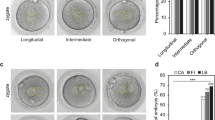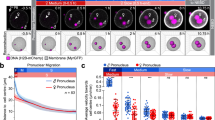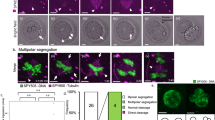ABSTRACT
Although male and female pronuclei reside in the same zygotic cytoplasm, they differ in many respects, such as volume and transcriptional activity. The aim of this study is to investigate whether these differences are lost during the first mitosis. For this purpose, a new method was developed to inhibit the mixing of two parental chromosomes during mitosis, thus to induce the formation of two nuclei after they exit from the mitotic phase. In this method, one-cell embryos are arrested at metaphase by treatment with nocodazole, and whn exitting from the mitotic phase, two nuclei were formed in a single karyocyte following treatment with 6-dimethylaminopurine (6-DMAP). These embryos were designated as post-mitotic embryos (PM-embryos), in which the two nuclei were derived from the male and female genomes. We found that in the control one-cell embryos that had not been treated with the reagents, the volume of the male pronucleus was about 1.65-fold greater than that of the female pronucleus, whereas the volumes of the two nuclei in the PM-embryos were similar (volume ratio of 1.01). Although a two-fold difference in transcriptional activity was detected between the male and female pronuclei in the control embryos, no difference in transcriptional activity was detected between the two nuclei of PM-embryos. The ratio of transcriptional activity in the nucleus derived from the paternal genome to that from the maternal genome was 1.02, for which no significant difference was detected by the χ2 fitness test. Therefore, the volumes and transcriptional activities of the male and female nuclei were approximately equal in PM-embryos, which suggests that the asymmetries of pronuclear volume and transcriptional activity between male and female genomes are somehow losted during the first mitosis.
Similar content being viewed by others
Log in or create a free account to read this content
Gain free access to this article, as well as selected content from this journal and more on nature.com
or
References
Aoki F, Worrad DM, Schultz RM . Regulation of transcriptional activity during the first and second cell cycles in the preimplantation mouse embryo. Dev Biol 1997; 181:296–307.
Ram PT, Schultz RM . Reporter gene expression in G2 of the 1-cell mouse embryo. Dev Biol 1993; 156:552–6.
Bouniol C, Nguyen E, Debey P . Endogenous transcription occurs at the 1-cell stage in the mouse embryo. Exp Cell Res 1995; 218:57–62.
Adenot PG., Mercier Y, Renard JP, Thompson EM . Differential H4 acetylation of paternal and maternal chromatin precedes DNA replication and differential transcriptional activity in pronuclei of 1-cell mouse embryos. Development 1997; 124:4615–25.
Mayer W, Niveleau A, Walter J, Fundele R, Haaf T . Demethylation of the zygotic paternal genome. Nature 2000; 403:501–3.
Cho T, Sakai S, Nagata M, Aoki F . Involvement of chromatin structure in the regulation of mouse zygotic gene activation. Animal Science Journal 2002; 73:113–22.
Martinez-Balbas MA, Dey A, Rabindran SK, Ozato K, Wu C . Displacement of sequence-specific transcription factors from mitotic chromatin. Cell 1995; 83:29–38.
Whitten, WK . Nutrient requirement for the culture of preimplantation embryos. Adv Biosci 1971; 6:129–39.
Chatot CL, Ziomek CA, Bavister BD, Lewis JL, Torres I . An improved culture medium supports development of random-bred 1-cell mouse embryos in vitro. J Reprod Fertil 1989; 86:679–88.
Arney KL, Bao S, Bannister AJ, Kouzarides T, Surani MA . Histone methylation defines epigenetic asymmetry in the mouse zygote. Int J Dev Biol 2002; 46:317–20.
Cowell IG, Aucott R, Mahadevaiah SK, et al. Heterochromatin, HP1 and methylation at lysine 9 of histone H3 in animals. Chromosoma 2002; 111:22–36.
Liu H, Kim JM, Aoki F . Regulation of histone H3 lysine 9 methylation in oocytes and early preimplantation embryos. Development 2004; 131:2269–80.
Neant I, Guerrier P . 6-Dimethylaminopurine blocks starfish oocyte maturation by inhibiting a relevant protein kinase activity. Exp Cell Res 1988; 176:68–79.
Anderiesz C, Fong CY, Bongso A, Trounson AO . Regulation of human and mouse oocyte maturation in vitro with 6-dimethylaminopurine. Hum Reprod 2000; 15:379–88.
Samake S, Smith LC . Effects of cell-cycle arrest agents on cleavage and development of mouse embryos. J Exp Zool 1996; 274:111–20.
Morgan DO, Kaplan JM, Bishop JM, Varmus HE . Mitosis-specific phosphorylation of p60c-src by p34cdc2 associated protein kinase. Cell 1989; 57:775–86.
Otto H, Dreger M, Bengtsson LK, Hucho F . Identification of tyrosine-phosphorylated proteins associated with the nuclear envelope. Eur J Biochem 2001; 268:420–8.
Motlik J, Rimkevicova Z . Combined effect of protein phosphorylation and protein symthesis inhibitors on maturation of mouse oocytes in vitro. Mol Reprod Dev 1990; 27:230–4.
Fulka J Jr, Leibfried-Rutledge ML, First NL . Effect of 6-dimethylaminopurine (6-DMAP) on germinal vesicle breakdown (GVBD) of bovine oocytes. Mol Reprod Dev 1991; 29:379–84.
Neant I, Guerrier P . Meiosis reinitiation in the molusc Patella vulgata. Regulation of MPF, CSF and chromosome condensation activity by intracellular pH, protein synthesis, and phosphorylation. Development 1988; 102:505–16.
Diberardino MA, Hoffner NJ, Orr NH . Genomic potential of erythroid and leukocytic cells of Rana pipiens analyzed by nuclear transfer into diplotene and maturing oocytes. Differentiation 1992; 50:1–13.
Wakayama T, Perry ACF, Zuccotti M, Johnson KR, Yanagimachi R . Full-term development of mice from enucleated oocytes injected with cumulus cell nuclei. Nature 1998; 394:369–72.
Dominko T, Mitalipova M, Haley B, et al. Bovine oocyte cytoplasm supports development of embryos produced by nuclear transfer of somatic cell nuclei from various mammalian species. Biol Reprod 1999; 60:1496–502.
Kim JM, Ogura A, Nagata M, Aoki F . Analysis of the mechanism for chromatin remodeling in embryos reconstructed by somatic nuclear transfer. Biol Reprod 2002; 67:760–6.
Heard E, Rougeulle C, Arnaud D, et al. Methylation of histone H3 at lys-9 is an early mark on the X chromosome during X inactivation. Cell 2001; 107:727–38.
Jacobs SA, Tavema SD, Zhang Y, et al. Specificity of the HP1 chromo domain for the methylated N-terminus of histone H3. EMBO J 2001; 20:5232–41.
Noma K, Allis CD, Grewal SI . Transitions in distinct histone H3 methylation patterns at the he terochromatin domain boundaries. Science 2001; 293:1150–5.
Boggs BA, Cheung P, Heard E, Spector DL, Chinault AC, Allis CD . Differentially methylated forms of histone H3 show unique association patterns with inactive human X chromosomes. Nat Genet 2001; 30:73–6.
Peters AH, Mermoud JE, O'Carroll D, et al. Histone H3 lysine 9 methylation is an epigenetic imprint of facultative heterochromatin. Nat Genet 2002; 30:77–80.
Hwang KK, Eissenberg JC, Worman HJ . Transcriptional repression of euchromatic genes by Drosophila heterochromatin protein 1 and histone modifiers. Proc Natl Acad Sci USA 2001; 98:11423–7.
Nielsen SJ, Schneider R, Bauer UM, et al. Rb targets histone H3 methylation and HP1 to promoters. Nature 2001; 412:561–5.
Author information
Authors and Affiliations
Corresponding author
Rights and permissions
About this article
Cite this article
LIU, H., HARA, K. & AOKI, F. Role of the first mitosis in the remodeling of the parental genomes in mouse embryos. Cell Res 15, 127–132 (2005). https://doi.org/10.1038/sj.cr.7290277
Received:
Revised:
Accepted:
Issue date:
DOI: https://doi.org/10.1038/sj.cr.7290277



